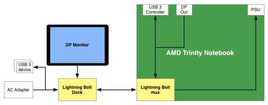- Joined
- Oct 9, 2007
- Messages
- 47,598 (7.45/day)
- Location
- Dublin, Ireland
| System Name | RBMK-1000 |
|---|---|
| Processor | AMD Ryzen 7 5700G |
| Motherboard | Gigabyte B550 AORUS Elite V2 |
| Cooling | DeepCool Gammax L240 V2 |
| Memory | 2x 16GB DDR4-3200 |
| Video Card(s) | Galax RTX 4070 Ti EX |
| Storage | Samsung 990 1TB |
| Display(s) | BenQ 1440p 60 Hz 27-inch |
| Case | Corsair Carbide 100R |
| Audio Device(s) | ASUS SupremeFX S1220A |
| Power Supply | Cooler Master MWE Gold 650W |
| Mouse | ASUS ROG Strix Impact |
| Keyboard | Gamdias Hermes E2 |
| Software | Windows 11 Pro |
AMD's competitive technology to Intel Thunderbolt, called "Lightning Bolt" (codename, marketing name may differ), surfaced at CES, where AMD was showing off its upcoming "Trinity" accelerated processing units. The technology was dissected by Anandtech, revealing exactly how AMD plans to achieve its goal of providing a much lower-cost alternative to Thunderbolt, over a similar-looking interface. While Thunderbolt is essentially PCI-Express x4 over DisplayPort, Lightning Bolt is the much more mature USB 3.0 SuperSpeed over DisplayPort. It is a single cable that combines a USB 3.0 with DisplayPort (display), and power (sourced directly from the PSU).
The part that makes it affordable is that AMD has already mastered GPU technologies that allow several displays connected to its GPUs using DisplayPort daisy-chaining; while USB 3.0 controllers are getting cheaper by the quarter. Connections of DisplayPort, USB 3.0 and power converge at a Lightning Bolt multiplex, from which the actual ports emerge. Lightning Bolt will stick to established mini-DisplayPort specifications.

AMD has a lot invested in the success of its next-generation mobile platform based on its "Trinity" accelerated processing unit, and has no plans to help Intel propagate Thunderbolt on its mobile platform. The "Trinity" APU combines next-generation "Piledriver" x86-64 computing modules with a powerful Radeon HD 7000 series embedded graphics core, which takes advantage of AMD's Graphics CoreNext architecture, supporting DirectX 11.1.
View at TechPowerUp Main Site
The part that makes it affordable is that AMD has already mastered GPU technologies that allow several displays connected to its GPUs using DisplayPort daisy-chaining; while USB 3.0 controllers are getting cheaper by the quarter. Connections of DisplayPort, USB 3.0 and power converge at a Lightning Bolt multiplex, from which the actual ports emerge. Lightning Bolt will stick to established mini-DisplayPort specifications.

AMD has a lot invested in the success of its next-generation mobile platform based on its "Trinity" accelerated processing unit, and has no plans to help Intel propagate Thunderbolt on its mobile platform. The "Trinity" APU combines next-generation "Piledriver" x86-64 computing modules with a powerful Radeon HD 7000 series embedded graphics core, which takes advantage of AMD's Graphics CoreNext architecture, supporting DirectX 11.1.
View at TechPowerUp Main Site
Last edited:


 J/K
J/K



